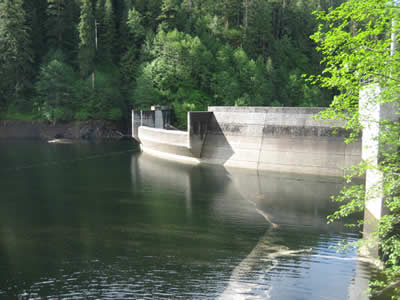The Swan Lake hydroelectric dam expansion project got a big boost this week from the Senate Finance Committee.
When the committee’s proposed capital budget was unveiled, it included about $3.3 million for the Southeast Alaska Power Agency’s plan to raise the Swan Lake Dam by about six feet.
That might not sound like much, but it will make a big difference to southern Southeast hydropower, according to SEAPA’s CEO, Trey Acteson.
“I like to put that in terms of offsetting diesel,” he said. “What it will do is replace up to 800,000 gallons of diesel generation a year, as our diesel dependency grows.”
Energy demand is growing faster than expected among SEAPA’s three member communities – Ketchikan, Petersburg and Wrangell – and when the inexpensive hydroelectric power runs low, those communities turn to backup diesel generators.
If Swan Lake can hold more water, though, that means the hydropower will last longer.
“What it allows us to do is it allows us to capture water that would have been spilled over the dam,” he said. “As it is now, if we get large inflows and we can’t use the water fast enough. This will allow us to capture that and shift that over into the winter months when we would potentially have to supplement with diesel.”
Ketchikan Public Utilities is building a new hydroelectric project at Whitman Lake, and Acteson said that project works well with the planned Swan Lake expansion.
“As many people know, the Whitman project is essentially run-of-river. It comes out a small reservoir, but it only has about a day or two of reserves,” he said. “So if KPU could run Whitman and while they’re running, we could bank that water in Swan and not lose it. It’s actually a very nice marriage.”
The cost estimate for the Swan Lake project is $13.3 million. Acteson said he’s pleased with the Senate Finance Committee’s funding for the project, and he’s hoping the House might add a little more when the budget goes to that body.
Other potential funding sources include the Alaska Energy Authority’s Renewable Energy Fund program, and bonds.
Acteson said the project makes sense for southern Southeast Alaska.
“The great thing about the project is it utilizes existing infrastructure,” he said. “You don’t need a new powerhouse, you don’t need a new penstock, you don’t need a new dam – we’re just going to raise it – you don’t need new transmission. We’re essentially just maximizing an existing facility. We consider it the low-hanging fruit for the region.”
If all goes well, Acteson said the expansion project should be completed by the end of 2016.






